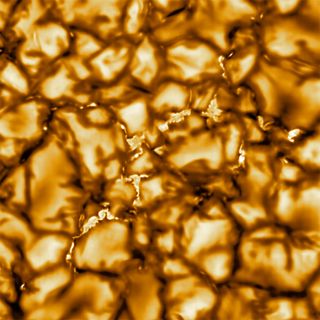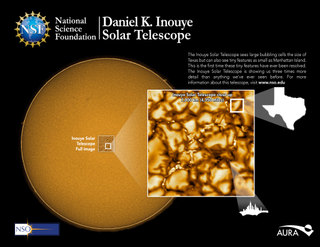The sun looks like caramel corn in highest-resolution image ever of our star
The world's largest solar telescope has revealed its first detailed image of the sun.
The Daniel K. Inouye Solar Telescope (DKIST), the world's largest solar telescope, captured its first image of the sun — the highest-resolution image of our star to date — last month.
The image begins what scientists hope will be a nearly 50-year study of the Earth's most important star. The new images reveal small magnetic structures in incredible detail. As construction on the 4-meter telescope winds down on the peak of Haleakala on the Hawaiian island of Maui, more of the telescope's instruments will begin to come online, increasing its ability to shed light on the active sun.
Inouye's unique resolution and sensitivity will allow it to probe the sun's magnetic field for the very first time as it studies the activities that drive space weather in Earth's neighborhood. Charged particles shed from the sun can interfere with Earth's mechanical satellites, power grids and communication infrastructure. The new telescope will also delve into one of the most counterintuitive solar mysteries: why the sun's corona, or outer layer, is hotter than its visible surface.
"These are the highest-resolution images and movies of the solar surface ever taken," Inouye director Thomas Rimmele said during a news conference on Friday (Jan. 24). "Up to now, we've just seen the tip of the iceberg."
Related: What's Inside the Sun? A Star Tour from the Inside Out

"A Swiss Army Knife"
Construction began on the Inouye Solar Telescope in 2012. Since then, the telescope has remained on budget and on schedule, according to Dave Boboltz, the program director for the National Science Foundation Astronomy Division.
The telescope captured the newly released image, which is its first engineering image, on Dec. 10, 2019, but the observatory is not yet complete. Only a single instrument, the Visible Broadband Imager (VBI), was operational at that time. The VBI takes extremely high-resolution images of the solar surface and lower atmosphere.
Sign up for the Live Science daily newsletter now
Get the world’s most fascinating discoveries delivered straight to your inbox.
The observatory's second instrument, the Visible Spectro-polarimeter (VISP), began operation on Thursday (Jan. 23). Like a prism, VISP splits light into its component colors to provide precise measurements of its characteristics along multiple wavelengths. The remaining instruments will be turned on as construction continues on the 13-story building, with full operations planned to begin in July 2020.
"We're now in the final sprint of a very long marathon," Rimmele said.
The first light-images captured are a false color image of the sun. Because the building is still under construction, the images were only processed but not analyzed for scientific results. However, Rimmele said that the magnetic structures that previously appeared in solar images as single bright points are now visible as several smaller structures, providing a hint the new solar telescope's capabilities.
The next instrument that will be delivered to the summit will be the Cryogenic Near Infrared Spectra-Polarimeter, which will study the solar atmosphere at infrared wavelengths, in order to probe magnetic fields in the sun's corona over a large field of view. Soon after, the Diffraction Limited Near Infrared Spectrom-Polarimeter will arrive, eventually using optical fibers to collect spectral data at every point in a two-dimensional solar image, allowing it to simultaneously measure spatial and spectral information. The final instrument, the Visible Tunable Filter, will capture very high-resolution images of the sun while performing high speed scans of the light that can identify atoms and molecules.
Inouye is meant to operate for 44 years, which should cover two of the sun's full 22-year solar cycles. Its suite of instruments will likely change over time.
"The real power in the Inouye Solar Telescope is its flexibility, its upgradability," Boboltz said. "It's like having a Swiss Army Knife to study the sun."

Solar solver
The sun constantly sheds material into space in all directions. This ongoing solar wind interacts with the Earth's magnetic field, causing the auroras.
Other outbursts are more dramatic. Occasionally, the sun will spit out large chunks of plasma and particles known as coronal mass ejections (CMEs); if these reach Earth, they can affect satellites and power grids, with the most powerful causing blackouts. One of the best-known modern catastrophes occurred in 1989 when a geomagnetic storm hit Quebec, sparking a nine-hour blackout across the Canadian territory. Studies have set the cost of a widespread blackout from tens of billions to trillions of dollars, depending on the circumstances.
Such effects could become more severe. "Our expanding dependence on technology greatly increases our vulnerability to space weather," Boboltz said.
The effects can be small but devastating. In September 2017, as a trio of hurricanes advanced across the Caribbean, solar flares caused multiple radio blackouts on the sunlit side of Earth. Multiple radio blackouts halted communications during the dangerous time, sometimes for as long as 8 hours.
"A naturally occurring event on Earth and a naturally event on the sun, when combined, represent a much bigger threat to our society," National Science Foundation Director Valentin Pillet said during the news conference.

The Inouye telescope should allow astronomers to learn more about what drives space weather. This understanding may help speed predictions for the most extreme events, allowing a faster response during dangerous situations.
Inouye will not act alone to accomplish this. "To really understand the drivers and the impact of space weather, we need to use two complementary approaches," Pillet said. Inouye will handle the first, making in-depth observations of the magnetic surface of the sun.
The second approach requires sending spacecraft close to the sun.
NASA's Parker Solar Probe launched in 2018 and will get within 4 million miles (6 million kilometers) at its closest approach to the star. In February, NASA and the European Space Agency will launch the Solar Orbiter, a mission dedicated to studying the sun's heliosphere, the bubble of charged particles blown into space by the solar wind.
The trio are "very complementary in different ways," Pillet said. While Inouye will provide a detailed look at the sun's magnetic field, the space missions will place its observations in context with solar activity and solar weather.
Together, "they will be at the forefront of discovery for the next half century," Pillet said. "It really is a great time to be a solar astronomer," he said.
"House of the sun"
Haleakala, Hawaiian for "House of the Sun," seems like the ideal setting for a solar telescope. World famous for its spectacular sunrises, the dormant volcano receives about 15 minutes more daylight than the sea-level portion of the island of Maui.
According to Hawaiian tradition, the volcano took its name from a trick played on the sun by the demi-god Maui. Maui's mother complained that the sun sped across the sky so fast that her cloth could not dry. The trickster climbed to the top of the mountain and lassoed the sun, refusing to release it until the sun agreed to slow down. To secure his release, the sun agreed to travel more slowly for six months of the year.
The spiritual significance of Hawaiian peaks has wreaked havoc for other telescopes. Protests about the growing astronomical presence on Mauna Kea have halted construction of the Thirty Meter Telescope. Inouye didn't escape opposition. In 2015 and 2017, hundreds of protesters gathered to block construction vehicles from traveling to the top of the peak.
Since then, the telescope's officials have met twice a year with a working group of native Hawaiians, whom they intend to bring to see the finished telescope. A new Science Support Center was also built at the base of the mountain to provide off-site support, and the peak remains open to native Hawaiians who wish to practice their religion on its slopes.
The National Solar Observatory has also put together a set of lesson plans for middle school teachers that highlight Hawaii's long history of astronomy that was presented to local teachers in 2019.
"We've been able to smooth over a lot of that contention," Boboltz said.
- A million geysers of plasma spout from the sun, and scientists may finally know why
- NASA eyes missions to track space weather threats with small satellites
- See the sun flip out in wild new satellite view
Follow Nola on Facebook and on Twitter at @NolaTRedd. Follow us on Twitter @Spacedotcom and on Facebook.

Most Popular




